From Virtual to Real: How AR/VR Brings the Digital World to Life
- Michael MAGES
- Jul 18, 2023
- 3 min read

The integration of augmented reality (AR) and virtual reality (VR) technologies has heralded a new era, blurring the lines between the physical and digital realms. These immersive experiences have revolutionized various industries, offering a gateway to unparalleled engagement and learning.
In this article, we will delve into the transformative potential of AR/VR training and how it paves the way for individuals to master the intricacies of AR/VR.
Understanding Augmented Reality (AR)
Augmented reality, or AR, is a technology that enriches the real world with virtual elements, heightening our perception and understanding of reality. Users can seamlessly interact with digital content integrated into their physical environment using smartphones, tablets, or specialized AR devices. Advanced sensors, cameras, and cutting-edge algorithms enable AR technology to detect and render virtual elements in real time, bridging the gap between the real and digital worlds.
Exploring Virtual Reality (VR)
Virtual reality, or VR, creates a wholly simulated environment that immerses users in a digital realm. By donning VR headsets or using VR-enabled devices, individuals can step into a virtual world and engage with objects and characters in a profoundly realistic and immersive manner. VR technology encompasses head-mounted displays, motion sensors, and hand controllers to deliver a fully immersive experience that transcends the physical world's limitations.
Unlocking the Potential of AR/VR Training. AR/VR training has become a powerful learning and skill development tool across diverse domains. Creating immersive learning environments empowers individuals to gain practical knowledge and expertise in AR/VR. Let's explore the remarkable applications and benefits of AR/VR training.
Education and Training
AR/VR training has the potential to revolutionize education and training by providing interactive and engaging experiences. AR overlays can superimpose informative graphics and interactive elements onto textbooks or real-world objects, fostering a dynamic and immersive learning environment. For example, architecture students can utilize AR/VR training to visualize and manipulate virtual building models, gaining hands-on experience before venturing into real-world projects. In medical education, AR/VR training allows aspiring healthcare professionals to interact with 3D anatomical models, aiding their understanding of complex structures. The immersive nature of AR/VR training enables students to learn through realistic simulations, enhancing their skills and confidence in various medical procedures.
Professional Skill Development
AR/VR training extends beyond academia, vital to professional skill development. Industries such as manufacturing, engineering, and aviation leverage AR/VR training to provide realistic simulations for training employees. For instance, aircraft maintenance technicians can undergo AR/VR training to practice complex procedures in a virtual environment, ensuring they acquire proficiency and precision before working on actual aircraft. In customer service, AR/VR training equips employees with simulated scenarios, allowing them to enhance their problem-solving and communication skills. Individuals can develop the necessary competencies to deliver exceptional customer experiences by engaging in lifelike situations.
Creating Engaging User Experiences
AR/VR training has transformed the way organizations create engaging user experiences. In architecture and interior design, clients can experience virtual walkthroughs of proposed methods, visualize spaces and make informed decisions before construction begins. The immersive nature of AR/VR training allows stakeholders to participate in the design process actively, ensuring their vision aligns with the outcome.
Empowering Healthcare and Medicine
The healthcare industry has embraced AR/VR training to enhance medical education, patient care, and surgical procedures. AR overlays enable medical professionals to access real-time patient data, visualize medical imaging, and receive guidance during surgical interventions. This integration of AR/VR training improves accuracy, reduces errors, and ultimately enhances patient outcomes. AR/VR training facilitates pain management, phobia treatment, and physical therapy in patient care. Virtual environments offer safe spaces for patients to confront their fears or engage in therapeutic exercises, promoting faster recovery and rehabilitation. Moreover, AR/VR training enables remote consultations and telemedicine, ensuring access to specialized care for individuals in remote or underserved areas.
Conclusion
AR/VR training is a transformative pathway to master augmented and virtual reality intricacies. By harnessing the power of immersive experiences, individuals can gain practical skills and expertise in various domains. From education and professional skill development to creating engaging user experiences and empowering healthcare, AR/VR training opens doors to a future where the boundaries between the real and digital worlds blur seamlessly.
Embrace the journey of learning AR/VR and unlock limitless possibilities in this dynamic realm.



Comments